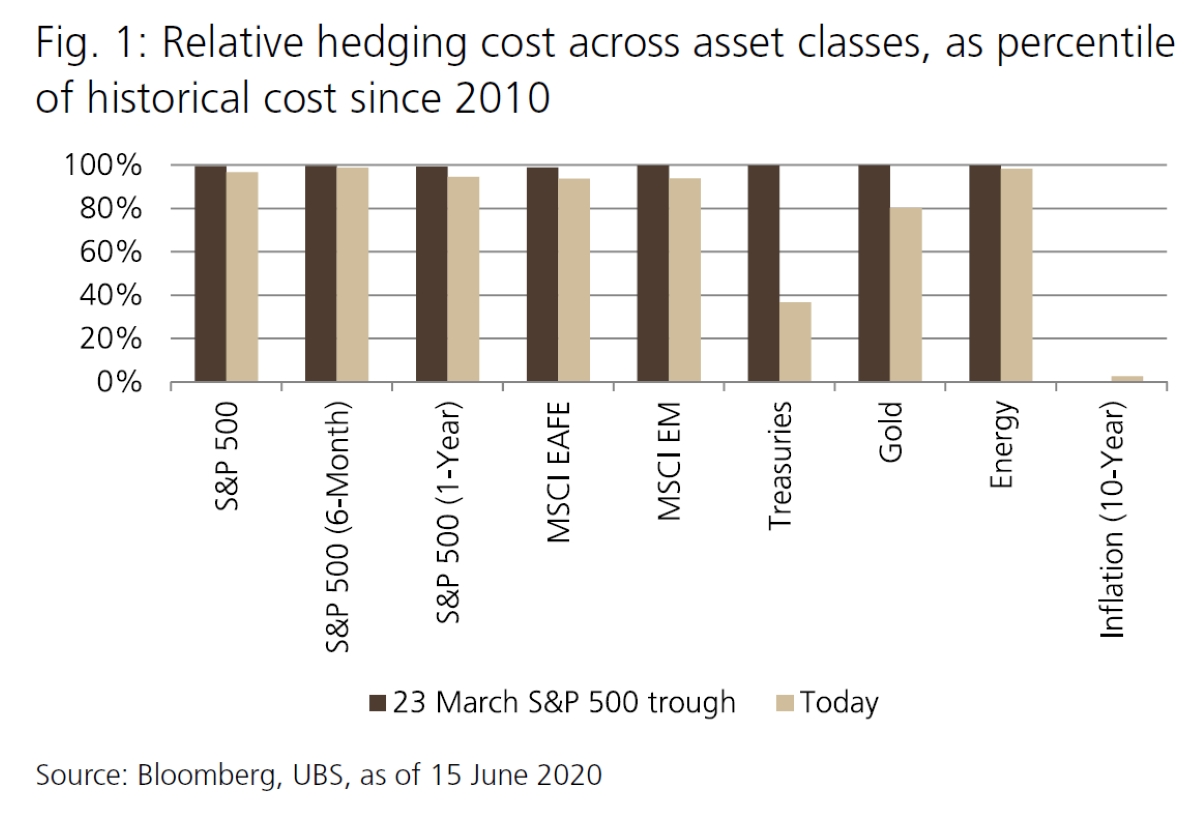

Finance
What Is Pre Hedging
Published: January 15, 2024
Discover the concept of pre-hedging in finance and how it can help mitigate risks. Enhance your understanding of this powerful risk management strategy.
(Many of the links in this article redirect to a specific reviewed product. Your purchase of these products through affiliate links helps to generate commission for LiveWell, at no extra cost. Learn more)
Table of Contents
Introduction
Pre hedging is a crucial concept in the world of finance. The term refers to the practice of hedging financial risks before they actually occur. By anticipating potential risks in financial transactions and taking proactive measures to mitigate them, pre hedging plays a vital role in ensuring stability and reducing potential losses in the volatile financial markets.
Pre hedging involves identifying and analyzing potential risks that may arise from market uncertainties, price fluctuations, interest rate changes, or any other factors that could negatively impact financial positions. Once these risks are identified, appropriate strategies and tools are employed to minimize their impact or offset them entirely. This proactive approach allows market participants to take preemptive measures to protect their portfolios and investments from adverse market conditions.
The primary objective of pre hedging is to manage and reduce risk exposure. By engaging in pre hedging activities, investors and financial institutions aim to limit potential losses and protect their investments. This strategy can be particularly effective in volatile markets where sudden fluctuations can have significant consequences.
In recent years, pre hedging has gained increased importance as financial markets become more complex and interconnected. With advancements in technology and increased market volatility, participants in various financial sectors, including banking, asset management, and trading, have recognized the need for robust risk management strategies.
Pre hedging is not limited to a specific type of financial instrument or market. It can be applied to various asset classes such as stocks, bonds, commodities, and derivatives. The techniques used in pre hedging can vary depending on the specific market and financial instruments involved.
In the following sections, we will delve deeper into the concept of pre hedging, explore its importance in financial markets, discuss the factors to consider when implementing pre hedging strategies, and provide examples of common pre hedging techniques. Understanding these concepts will provide valuable insights into the world of risk management and help market participants navigate the complexities of the financial markets more effectively.
Definition of Pre Hedging
Pre hedging is a risk management strategy employed in the financial industry to minimize potential losses by taking proactive measures to offset or mitigate anticipated risks before they materialize. It involves identifying and analyzing potential risks that may arise from market uncertainties, price fluctuations, interest rate changes, or any other factors that could negatively impact financial positions.
The concept of pre hedging revolves around the idea of anticipating risks and taking proactive steps to manage them before they actually occur. By identifying potential risks in advance, market participants can implement strategies to hedge against these risks, minimizing the impact on their portfolios and investments.
Pre hedging is not limited to a specific financial instrument or market. It can be applied across various asset classes, including stocks, bonds, commodities, and derivatives. The strategies and techniques used in pre hedging can vary depending on the specific market and financial instruments involved.
The goal of pre hedging is to manage risk exposure and protect investments. By taking preemptive measures, market participants aim to limit potential losses and ensure the stability of their portfolios. This proactive approach allows them to navigate through volatile market conditions and safeguard their financial positions.
Pre hedging involves a thorough analysis of potential risks and the implementation of appropriate risk mitigation strategies. It requires a deep understanding of the market dynamics, as well as knowledge of different hedging techniques and instruments. By effectively pre hedging, market participants can have greater control over their risk exposures and reduce the impact of adverse market fluctuations.
In summary, pre hedging is a risk management strategy that involves taking proactive measures to hedge against anticipated risks in the financial markets. It is a crucial practice for market participants seeking to protect their investments and navigate through uncertain market conditions.
Purpose of Pre Hedging
The purpose of pre hedging is to effectively manage and mitigate potential risks in the financial markets. By taking proactive measures to hedge against anticipated risks, market participants aim to protect their portfolios and investments from volatile market conditions.
One of the primary purposes of pre hedging is risk reduction. By identifying and analyzing potential risks in advance, market participants can implement appropriate strategies to offset or minimize the impact of these risks. This proactive approach allows investors and financial institutions to have better control over their risk exposures and reduce potential losses.
Pre hedging also serves to enhance stability in financial markets. By hedging against anticipated risks, market participants can help stabilize prices, reduce volatility, and create a more predictable environment for trading and investment activities. This stability is essential for market efficiency and investor confidence.
Another purpose of pre hedging is to provide insurance against adverse market fluctuations. By hedging their positions in advance, market participants can protect their investments from potential losses caused by sudden market movements. This insurance-like protection helps minimize the financial impact of unexpected events and provides a sense of security to investors.
Pre hedging also enables market participants to manage cash flow and liquidity. By hedging anticipated risks, investors can ensure they have sufficient liquidity to meet their financial obligations, even in the event of adverse market conditions. This proactive management of cash flow helps maintain financial stability and prevents potential liquidity crises.
Furthermore, pre hedging allows market participants to navigate regulatory requirements and restrictions. In some cases, financial institutions may be required to hedge certain positions or meet specific risk management criteria. By engaging in pre hedging activities, these institutions can ensure compliance with regulatory standards and avoid potential penalties or fines.
Overall, the purpose of pre hedging is to reduce risk exposure, enhance stability, provide insurance against adverse market movements, manage cash flow and liquidity, and meet regulatory requirements. By employing proactive risk management strategies, market participants can protect their investments and navigate through the complexities of the financial markets more effectively.
Importance of Pre Hedging in Financial Markets
Pre hedging plays a vital role in the financial markets by helping market participants manage and mitigate potential risks. It offers several important benefits and contributes to the overall stability and efficiency of the markets.
One of the key reasons for the importance of pre hedging is risk reduction. By identifying and analyzing potential risks in advance, market participants can implement hedging strategies to offset or minimize the impact of these risks. This proactive approach allows investors and financial institutions to have better control over their risk exposures, reducing the likelihood of significant losses.
Pre hedging also helps to enhance market stability. By hedging against anticipated risks, market participants can minimize price volatility and create a more predictable trading environment. This stability is essential for efficient price discovery, accurate valuations, and overall investor confidence. Without pre hedging, the markets could experience sharp fluctuations and heightened uncertainty, which can negatively impact investor sentiment and participation.
Another important aspect of pre hedging is its role in providing insurance against adverse market movements. By hedging their positions in advance, market participants can protect their investments from potential losses caused by sudden market disruptions. This insurance-like function provides a sense of security to investors, encouraging them to engage in trading and investment activities with greater confidence.
In addition, pre hedging facilitates efficient cash flow and liquidity management. By anticipating and hedging against risks, market participants can ensure they have sufficient liquidity to meet their financial obligations, even in adverse market conditions. This proactive approach to cash flow management helps maintain financial stability and prevents potential liquidity crises.
Furthermore, pre hedging is crucial for managing regulatory requirements and restrictions. Financial institutions often face specific risk management criteria or hedging obligations imposed by regulators. By engaging in pre hedging activities, these institutions can ensure compliance with regulatory standards, reducing the risk of penalties or fines.
Overall, the importance of pre hedging in financial markets lies in its ability to reduce risk exposure, enhance stability, provide insurance against adverse market movements, facilitate efficient cash flow management, and ensure compliance with regulatory requirements. By proactively managing risks, market participants can protect their investments and contribute to the smooth functioning of the financial markets.
Factors to Consider in Pre Hedging
Pre hedging is a complex process that requires careful consideration of various factors to ensure its effectiveness. Market participants need to evaluate these factors to develop and implement an appropriate pre hedging strategy. Here are some key factors to consider:
- Market Volatility: The level of market volatility is a critical factor to consider in pre hedging. Highly volatile markets may require more aggressive hedging strategies, while less volatile markets may allow for more conservative approaches.
- Risk Tolerance: Understanding one’s risk tolerance is essential in pre hedging. Different investors or institutions have varying levels of risk appetite, which can influence the selection of appropriate hedging instruments and techniques.
- Asset Class: Different asset classes have unique characteristics and risks. The choice of pre hedging strategies will depend on the specific asset class being considered, such as stocks, bonds, commodities, or derivatives.
- Correlation Analysis: Analyzing the correlations between different assets or market factors is crucial in pre hedging. Understanding how various factors interact and influence each other helps in designing effective hedging strategies that provide optimal risk reduction.
- Cost of Hedging: Evaluating the cost of implementing hedging strategies is essential. Pre hedging involves transaction costs, such as commissions and fees, as well as the cost of acquiring and maintaining hedging positions. Balancing the cost and benefit of hedging is crucial in decision-making.
- Problem Identification: Identifying and understanding potential risks and problems that may arise is a fundamental step in pre hedging. Market participants must conduct thorough research and analysis to identify the specific risks they need to hedge against.
- Time Horizon: The time horizon of a pre hedging strategy is another crucial factor. Some hedging strategies are intended for short-term protection, while others may be designed for long-term risk mitigation. The chosen strategy should align with the desired time horizon.
- Risk Assessment: Quantifying the potential impact of identified risks is important in pre hedging. Assessing the probability and potential magnitude of risks helps in determining the appropriate level of hedging and the selection of suitable hedging instruments.
- Regulatory Considerations: Market participants must also consider regulatory requirements and restrictions related to pre hedging. Compliance with regulatory standards is essential to avoid penalties or legal implications.
By carefully considering these factors, market participants can develop an effective pre hedging strategy that aligns with their risk tolerance, investment objectives, and market conditions. Regular monitoring and adjustments to the pre hedging strategy should also be undertaken to ensure its continued effectiveness in managing risk.
Pre Hedging Techniques
Pre hedging involves employing various techniques to mitigate potential risks in the financial markets. These techniques aim to offset or minimize the impact of anticipated risks on investments and portfolios. Here are some common pre hedging techniques:
- Long and Short Positions: Taking long and short positions in related financial instruments is a commonly used pre hedging technique. By simultaneously holding a long position in one asset and a short position in another, market participants can offset potential losses or gains due to price movements.
- Derivatives: Utilizing derivatives, such as options, futures, and swaps, is another widely adopted pre hedging technique. Derivatives allow market participants to hedge against specific risks by establishing contracts that derive their value from an underlying asset. These instruments can be used to protect against price fluctuations, interest rate changes, or other identified risks.
- Forwards and Futures Contracts: Pre hedging can also involve entering into forward or futures contracts to lock in future prices for anticipated purchases or sales. This technique enables market participants to hedge against price volatility and ensure a predictable cost or revenue stream.
- Options Contracts: Options contracts provide the right, but not the obligation, to buy or sell an underlying asset at a predetermined price within a specified timeframe. Utilizing options contracts allows market participants to hedge against specific market movements while maintaining flexibility in their trading decisions.
- Portfolio Diversification: Diversifying one’s investment portfolio is a pre hedging technique that helps mitigate risks. By investing in a range of different assets with varying risk profiles, market participants can reduce the overall impact of specific risks on their portfolio. This technique spreads risk across different asset classes and can potentially enhance risk-adjusted returns.
- Currency Hedging: For market participants involved in international trade or investments, currency hedging becomes important to protect against exchange rate fluctuations. Currency forwards, options, or futures contracts can be utilized to hedge exposure to currency risk and ensure stability in cross-border transactions.
- Macro Hedging Strategies: Macro hedging strategies involve hedging against broader market trends or macroeconomic factors. These strategies may include taking positions in market indices, commodities, or interest rate instruments to mitigate the impact of macroeconomic risks on a portfolio.
- Dynamic Hedging: Dynamic hedging involves actively adjusting hedge positions in response to market movements and changes in risk profiles. This technique requires continuous monitoring and proactive decision-making to maintain optimal risk reduction.
- Structured Products: Utilizing structured products is another pre hedging technique. These products combine multiple financial instruments or exposures to create customized risk profiles. They are designed to provide pre-determined payoffs based on specific market scenarios.
It is important to note that the selection and implementation of pre hedging techniques will depend on factors such as the type of risk being hedged, the market conditions, and the risk tolerance of market participants. It is recommended to consult with professionals or specialists to determine the most appropriate techniques for individual circumstances.
Risks and Challenges in Pre Hedging
While pre hedging is an important risk management strategy, it is not without its own set of risks and challenges. Market participants must be aware of these potential pitfalls and navigate them effectively to ensure the success of their pre hedging activities. Here are some key risks and challenges in pre hedging:
- Inaccurate Risk Assessment: One of the main challenges in pre hedging is the possibility of inaccurate risk assessment. If the identified risks are not properly analyzed or if market participants fail to accurately predict market movements, their pre hedging activities may not effectively protect against the anticipated risks.
- Over hedging or Under Hedging: Pre hedging requires finding the right balance between over hedging and under hedging. Over hedging can result in unnecessary costs and impact potential profits, while under hedging may leave portfolios exposed to significant risks. It requires careful judgment and analysis to strike the right balance.
- Market Timing: Timing is critical in pre hedging. Market participants need to accurately time their hedge positions to coincide with the anticipated risks. If the timing is incorrect, the effectiveness of the pre hedging strategy may be diminished, and potential losses may still occur.
- Technique Selection and Execution: Choosing the most appropriate pre hedging technique and executing it effectively can be challenging. Each technique comes with its own complexities and considerations. Market participants need to have a deep understanding of the chosen technique and its implications to ensure its success.
- Transaction Costs: Engaging in pre hedging activities incurs transaction costs, such as commissions and fees, which can eat into potential profits. These costs need to be carefully considered and accounted for when evaluating the overall effectiveness and cost-benefit analysis of a pre hedging strategy.
- Regulatory and Compliance Considerations: Pre hedging activities must comply with regulatory requirements and restrictions. Failure to adhere to these regulations can result in penalties or legal consequences. Market participants need to navigate the regulatory landscape and ensure full compliance in their pre hedging practices.
- Counterparty Risk: Pre hedging often involves entering into contracts or agreements with counterparties. The risk of counterparty default or non-performance is a significant challenge. Careful due diligence on counterparties and the use of appropriate risk mitigation measures such as collateral or credit enhancements are necessary to mitigate this risk.
- Market Liquidity and Availability: Some pre hedging techniques require access to liquid markets and readily available instruments. Illiquid markets or limited availability of suitable hedging instruments can pose challenges and limit the effectiveness of pre hedging strategies.
- Unforeseen Events: Pre hedging strategies may not account for unforeseen events or “black swan” events that can have a significant impact on the markets. These events can render pre hedging techniques ineffective or insufficient in hedging against such extreme or unexpected risks.
Market participants must carefully assess these risks and challenges and develop appropriate risk mitigation strategies to address them. Regular monitoring, evaluation, and adjustments to pre hedging strategies are essential to ensure their ongoing effectiveness in managing risks.
Examples of Pre Hedging Strategies
Pre hedging strategies can vary depending on the specific risks and market conditions. Here are a few examples of common pre hedging strategies employed by market participants:
- Interest Rate Swap: In anticipation of rising interest rates, market participants may enter into interest rate swap contracts. This allows them to exchange fixed-rate interest payments for floating-rate interest payments or vice versa. By engaging in an interest rate swap, market participants can hedge against potential interest rate fluctuations and protect their portfolios from interest rate risks.
- Commodity Futures Contracts: Market participants involved in commodities trading may use futures contracts to pre hedge against price volatility. For example, a manufacturer who relies heavily on a particular commodity can enter into futures contracts to lock in the purchase price of the commodity. This helps mitigate the risk of price fluctuations and ensures a predictable cost of raw materials.
- Stock Index Options: Investors may use stock index options as a pre hedging strategy to protect their portfolios against market downturns. By purchasing put options on a stock market index, investors have the right but not the obligation to sell their underlying portfolio holdings at a predetermined price. This provides insurance-like protection against potential market declines.
- Foreign Exchange Forwards: Businesses engaged in international trade can pre hedge their foreign exchange risk by entering into forward contracts. Forward contracts allow companies to lock in exchange rates for future currency transactions, protecting against adverse currency fluctuations. This ensures stable pricing and mitigates the risk of uncertain foreign exchange rates impacting profitability.
- Options Collar: Investors in individual stocks can implement an options collar strategy to pre hedge against downside risk. This involves buying put options to protect against potential stock price declines while simultaneously selling call options to generate income. The options collar limits potential losses while allowing for potential upside gains.
- Macro Hedging: Institutions with exposure to multiple markets and macroeconomic factors may implement macro hedging strategies. This involves taking positions in various assets, such as stocks, bonds, and currencies, to offset potential risks associated with broad market trends or macroeconomic events. Macro hedging aims to protect against systemic risks that could impact an entire portfolio or business.
- Diversification and Asset Allocation: Diversifying investment portfolios across different asset classes and geographical regions is a pre hedging strategy that helps spread risks. By allocating investments to a mix of stocks, bonds, commodities, and real estate, investors aim to reduce the impact of specific risks and achieve a more balanced and resilient portfolio.
- Dynamic Hedging: Some investors use dynamic hedging techniques to adjust their hedging positions based on market conditions. For example, an investor who holds a portfolio of stocks may adjust their hedging positions by actively buying or selling options contracts as the market fluctuates. This allows for more responsive risk management in changing market conditions.
These are just a few examples of pre hedging strategies, and the specific approach chosen will depend on factors such as the type of risk being hedged, market conditions, and individual risk preferences. It is important for market participants to carefully assess their unique circumstances and seek professional advice to determine the most suitable pre hedging strategies for their specific objectives.
Conclusion
Pre hedging is a vital risk management strategy in the financial markets. It involves proactively identifying and mitigating potential risks before they materialize, thereby protecting portfolios and investments from adverse market conditions. By anticipating risks and implementing appropriate hedging strategies, market participants aim to reduce risk exposure, enhance stability, and ensure the resilience of their financial positions.
The importance of pre hedging lies in its ability to help manage risk, provide insurance against adverse market movements, ensure stable cash flow, and comply with regulatory requirements. Through careful analysis and consideration of factors such as market volatility, risk tolerance, and asset class correlations, market participants can develop effective pre hedging strategies tailored to their specific needs.
However, pre hedging is not without its challenges. Accurate risk assessment, disciplined execution, market timing, regulatory compliance, and counterparty risk are among the potential hurdles that market participants must navigate. Additionally, unforeseen events and unexpected market developments can impact the effectiveness of pre hedging strategies.
Examples of pre hedging strategies include interest rate swaps, commodity futures contracts, stock index options, foreign exchange forwards, options collars, macro hedging, and diversification. These strategies enable market participants to protect against price volatility, interest rate fluctuations, currency risk, and broad market trends.
In conclusion, pre hedging serves as a valuable tool for managing risks and safeguarding financial positions. By taking proactive measures to hedge against anticipated risks, market participants can navigate uncertainties in the financial markets with greater confidence. The successful implementation of pre hedging techniques requires a deep understanding of market dynamics, careful risk assessment, and continuous monitoring and adjustments. With these considerations in mind, market participants can enhance risk management, protect investments, and contribute to the overall stability and efficiency of the financial markets.














